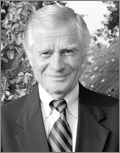204th ECS Meeting | Orlando, FL | Oct. 13, 2003

When Will We Be Able to Buy and Drive Fuel Cell Electric Vehicles

When Will We Be Able to Buy and Drive Fuel Cell Electric Vehicles
Fritz Kalhammer, formerly of the Electric Power Research Institute (EPRI) and now an independent consultant in energy and process technology, gave the plenary lecture (with the above title) on Monday morning. If the packed fuel cell sessions that followed were anything to go by, the topic of this lecture could not have been more relevant and timely. Dr. Kalhammer discussed the possibility of fuel cell-powered vehicles that would be available at an affordable price and with a performance at par with gasoline-powered internal combustion (IC) engines. He pointed out that auto companies had “promised” the consumers that this technology will arrive in 2004 and had invested billions of dollars into the R&D effort. In fact, more dollars have been put into electric vehicles than any electrochemical technology over a 30 year time span. Yet it appears that we will not be able to buy these vehicles even by the end of this decade. An examination of the underlying factors in this dilemma constituted the crux of his lecture.
Dr. Kalhammer first charted the historical development of fuel cell powered vehicles starting with the General Motors Electrovan of 1967 and Kordesch’s Austin A40 of 1970. However both these prototypes paled in performance against their IC engine counterparts along with other problems coupled to high costs and short fuel cell stack life—challenges that remain to this day. For example, fuel cell cars cost $1,000/kW as compared to $30/kW for a conventional vehicle equipped with an IC engine. However other key developments have occurred since these early years including the Los Alamos work on polymer electrolyte membrane (PEM) fuel cells and optimization of the Pt catalyst loading, the seven-layer membrane electrode assembly (MEA) developed by 3M Corporation, and demonstration of high-performance PEM stacks and modules by Ballard Engineering in Canada. All these accomplishments presage a bright future for fuel cell powered vehicles. In fact several major auto companies in Germany, Japan, and the U.S. have entered the fray and Dr. Kalhammer pointed out that their prototype vehicles are now undergoing field tests under the California Partnership for Clean Air program.
The next part of Dr. Kalhammer’s talk focused on fuel cell cost issues and what could be done to bring cost down to commercially viable levels. He mentioned that while government subsidies and tax credits could well prove to be vital to continued development of this technology, the car makers did not particularly like them in terms of reliability concerns. The other major issue was the fuel cost; clearly any new fuel cannot cost too much more than gasoline notwithstanding the advantages of electric vehicles in terms of clean emissions. The prospects of methanol as a fuel and fuel processing (reformate) approaches were then discussed. Hydrogen was discussed as the clear long term winner as a fuel candidate and associated issues with a hydrogen fuel economy were presented.
Dr. Kalhammer moved toward the end of his lecture by saying that we needed to break out of a Catch-22 situation in terms of realization of the fuel cell vehicle concept. The break out factors were identified as severely escalating gasoline costs, increasing global climate change awareness, new financial incentives along with a series of major cost and technology breakthroughs. In his crystal ball we are perhaps 15-20 years away from commercial realization of fuel cell electric vehicles.
This was a well-crafted talk from a veteran with his pulse close to the fuel cell and electric vehicle technologies. It was very well received by a packed audience and it set the right tone for the many sessions that followed on fuel cells (including an exceedingly popular tutorial session) the rest of the week.
